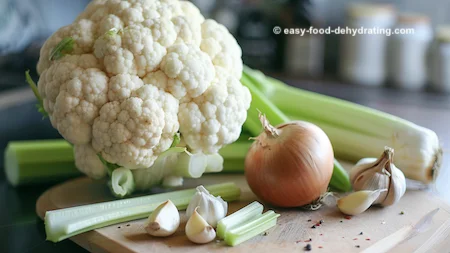What We Mean by “Dehydrate”
Here at Easy Food Dehydrating, “dehydrate” always means using an electric food dehydrator — the easy, reliable way to dry food at home.
- Home
- Easy Dehydrated Food Recipes
- Cauliflower Soup Recipe
Cauliflower Soup:
Warm, Wholesome, & Delicious

This cozy cauliflower soup is creamy, comforting, and surprisingly dairy-free. Thanks to the natural creaminess of blended cauliflower, you’ll enjoy a rich, velvety bowl without any added cream. It’s nourishing, easy to prepare, and perfect for both quick weeknight dinners and lazy weekend lunches.
✅ Quick Answer: How do you make cauliflower soup?
To make cauliflower soup, rehydrate (or chop fresh) cauliflower, onion, celery, and garlic, then simmer with vegetable stock, millet or quinoa, and seasonings. Blend until smooth for a creamy, dairy-free soup that’s rich, wholesome, and satisfying.
Whether you’re using dehydrated veggies from your pantry or a fresh head of cauliflower, this recipe adapts beautifully. Every spoonful delivers warmth, flavor, and wholesome comfort you’ll want to make again and again.

Got pent-up frustration? No problem! Take it out on the cauliflower as you chop away—instant stress relief! But if you’re using dehydrated cauliflower, you can skip the chopping and stay calm, cool, and collected while this delicious soup practically makes itself.
Either way, you’ll end up with a satisfying bowl of creamy goodness that’s both easy to make and full of flavor!

Cauliflower Soup Recipe
Rich, Thick, Smooth, and Satisfying!
As noted below in the "how to" area coming up, please remember to rinse your millet and quinoa before adding it to the mix (especially the quinoa because it has a really bitter taste if you don't rinse it first).
Ingredients
- 1/8 cup dehydrated onion
- 1/8 cup dehydrated celery
- 2 cups dehydrated cauliflower
- 2 slices dehydrated elephant garlic
- 2 cups boiling water (for the dehydrated items)
- 1/8 cup millet, optional—rinse first
- 1/8 cup quinoa, optional—rinse first
- salt* and pepper to taste
- 4 cups of vegetable stock
- 1/2 teaspoon Cumin
- 2 tablespoons fresh chopped parsley, and a sprig for garnish!
NOTE: If you wish to make this delicious soup from fresh cauliflower, you can use the entire head of it. Yes, it will just about fill up the whole pan, but it does 'cook down'! Sprinkle on some chopped parsley for a nice garnish touch!
If you prefer your soup a little thinner, at the end of cooking add half a cup of vegetable stock. But as I mentioned at the top of the page, I just love how thick and creamy this cauliflower soup is!
Also, at the bottom of this page is more information on the goodness of adding millet and quinoa to your diet.
Instructions
- Use the freshly boiled water to rehydrate the dehydrated items above.
- When they are sufficiently plump, put the veggies into a heavy saucepan (with the optional millet and quinoa—RINSE the millet and quinoa first in a fine-sieve in the sink to get rid of the bitter taste).
- Add the chopped parsley, vegetable stock, and cumin, and cook for 15-20 minutes, until the cauliflower is fully cooked/soft.
- Use a blender to mix in small batches... allow the air to escape from the little hole in the lid so that the heat doesn't cause any explosive problems! Just have your hand over that top little hole to catch any runaway splashes.
- Blend until smooth, about 45 - 60 seconds. Serve with an added sprig of parsley for garnish!
*IF you need to add salt, do so, BUT be careful NOT to over-salt as the bouillon has salt in it.
Nutrition Information
- Servings: 6 servings
- Calories: 83kcals
- Fat: 0.9g
- Protein: 3.9g
- Carbohydrates: 16.5g

Fresh vs. Dehydrated: Which Cauliflower Works Best?
If you want to use fresh ingredients that you may have on hand, do this:

Exchange the dry ingredients in the recipe, above, for these fresh ingredients listed below!
- 3/4 to a whole head of cauliflower - remove outer leaves and break down into florets - wash if needed
- 1/4 large onion, peeled and diced
- 1 celery stalk, sliced
- 2 slices fresh elephant garlic, or 1 small clove of "regular sized" garlic
White, Orange, or Purple? The Truth About Cauliflower Colors

The color of cauliflower comes from natural plant pigments. Purple cauliflower gets its vibrant hue from anthocyanins, the same antioxidants found in blueberries and eggplant.
Orange cauliflower owes its color to carotenoids, the same pigments that give carrots and sweet potatoes their bright orange shade.
White cauliflower, on the other hand, lacks these pigments, which is why it remains its classic pale color!
20 Taste-Tested Easy Recipes
🍕 Pizza! 🥧 Shepherd's Pie! 🥘 Beef Stew! plus
Cauliflower Soup and Cauliflower Mash, along with crazy Carrot Soup!
Decadent Desserts: Carrot Cake and Cranberry Pineapple Pie!
and more...
Fresh food ingredient amounts are included for when you have fresh food on hand.
See which recipes are included here.
Millet in Soup? Nutrition Benefits You’ll Love
Millet is a highly nutritious, gluten-free grain that offers several health benefits:
- Packed with Nutrients – Millet is rich in protein, fiber, antioxidants, magnesium, phosphorus, and other essential minerals, making it a powerhouse for overall wellness.
- Easy to Digest – As an alkalizing and non-acidic grain, millet is gentle on the stomach and one of the least allergenic grains, making it easier to digest than many other options.
- Supports Gut Health – Millet contains prebiotic carbohydrates that nourish beneficial gut bacteria, promoting better digestion and overall gut balance.
- Naturally Gluten-Free – A perfect alternative for those with Celiac disease or gluten intolerance, millet provides a safe, nutrient-dense substitute for wheat and other gluten-containing grains.
With its versatility, digestibility, and impressive nutrient profile, millet is a fantastic addition to a healthy diet!
Quinoa in Soup: Why This Superfood Boosts Every Bowl
Quinoa is an exceptionally nutritious grain alternative packed with benefits:
- Complete Protein Powerhouse – Unlike most plant-based foods, quinoa contains all nine essential amino acids, making it a complete protein. With about 4 grams of protein per 1/4 cup (uncooked), it’s an excellent choice for vegetarians and vegans.
- High in Fiber – With 5 grams of fiber per 1/4 cup, quinoa supports healthy digestion, promotes fullness, and helps maintain balanced blood sugar levels.
- Steady Energy Source – As a complex carbohydrate, quinoa digests slowly, providing a long-lasting energy boost without sugar crashes.
- Iron-Rich – Quinoa contains significantly more iron than most grains, helping transport oxygen throughout the body and reduce the risk of anemia.
- Loaded with Antioxidants – It’s packed with quercetin, kaempferol, and ferulic acid, powerful antioxidants that combat free radicals and help reduce inflammation.
- Diabetes-Friendly – With a low glycemic index of 53, quinoa won’t cause sharp blood sugar spikes, making it a smart choice for those managing diabetes.
- Naturally Gluten-Free – A safe and nutritious option for anyone with Celiac disease or gluten sensitivity.
- Versatile & Delicious – Its mild, nutty flavor makes quinoa perfect for both sweet and savory dishes, from breakfast porridge to hearty grain bowls.
With its high protein, fiber, and essential nutrients, quinoa is a superfood worth adding to your diet!
Cauliflower Soup Questions People Ask
Can I make cauliflower soup without a blender?
Can I make cauliflower soup without a blender?
Yes. If you don’t have a blender, use a potato masher or immersion blender for a slightly chunkier soup. It won’t be as silky smooth, but it’s still delicious.
How do I thicken cauliflower soup naturally?
How do I thicken cauliflower soup naturally?
Cauliflower naturally creates creaminess when blended. For extra thickness, simmer a bit longer or add cooked potatoes, millet, or quinoa before blending.
Can I freeze cauliflower soup?
Can I freeze cauliflower soup?
Absolutely. Let the soup cool, portion it into airtight containers, and freeze for up to 3 months. Reheat gently on the stove while stirring.
Thanks so much for stopping by today to try my cauliflower soup recipe. If you enjoyed this one, you’ll love my other pantry-friendly favorites like carrot soup, minestrone, and even spicy beef jerky for a savory twist.
Be sure to grab your free 5 Dried Food Recipes You'll Actually Love PDF below—it includes those recipes plus banana cinnamon rolls for a sweet finish.
Get 5 Dried Food Recipes You'll Actually Love
Here's where you can get your copy of our all new
5 Dried Food Recipes (That Actually Taste Great)
They're my all-time favorite easy dried food meals!
Get it here right now.
For Free!
Before You Go...
If you enjoyed this page, tap the ❤️ in the lower right-hand corner.
It saves this page to your Grow bookmarks so you can find it again later.
You’ll also see quick share buttons to copy the link, post to Facebook,
or save it straight to Pinterest.


















